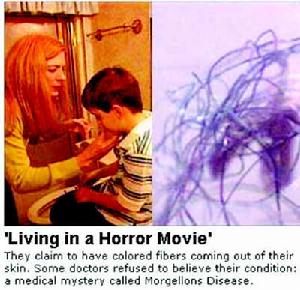Top 10 strange diseases of human beings: "laughing to death disease" originates from the custom of eating deceased relatives
Morgellons Disease: Information and Pictures
According to CNN, after mad cow disease and SARS, it is now the H1N1 influenza that has caught media attention. But currently, there are many people around the world suffering from very rare diseases, among which many strange illnesses we may have never heard of. From the "Alice in Wonderland" syndrome that might have inspired Lewis Carroll to the illness that could have driven a British king insane, these strange diseases sound unbelievable and also puzzle the medical community.
1. Morgellons Disease
According to data from the Morgellons Research Foundation, nearly 14,000 people suffer from this disease. Patients feel as if something like parasites are crawling under their skin, accompanied by sensations of biting and stinging, and their skin excretes strange blue, black, and red fibrous substances. This disease is often associated with fatigue, short-term memory loss, joint pain, and changes in vision. In 2002, a woman named this condition Morgellons disease; she believed her 2-year-old son was afflicted with it. The name comes from a skin disease discovered in France in the 17th century, where children would die after growing "black hair." However, whether this disease truly exists has been controversial.
In March 2008, the Journal of Dermatological Treatment reported that most doctors believe this is a delusion, where patients mistakenly think they are infected with parasites. Therefore, the fibers on the skin are traces left after scabs fall off, which could be from common eczema or scabies. Due to increasing public doubts, the U.S. Centers for Disease Control and Prevention recently announced an investigation into this disease.
2. Progeria
Progeria is a congenital disease, indicating defects or damage present during the fetal stage. Patients exhibit premature aging symptoms but have an average life expectancy of only 13 years. Symptoms start between 9 to 24 months, showing delayed growth. Their facial development is abnormal, with disproportionately small faces, protruding eyes, and underdeveloped chins. By age 2, their hair, eyebrows, and eyelashes fall out. The National Organization for Rare Disorders in the U.S. stated that patients eventually lose subcutaneous fat, and the elasticity of arterial walls diminishes, leading to 90% of patients dying from heart disease or strokes.
3. Water Allergy
So far, only 30 cases of this disease have been found. Water allergy, or "aquagenic urticaria," is extremely rare, but the U.S. Medical Evaluation Council confirmed its existence. Patients seem to be allergic to water. Water allergy usually occurs in adulthood and is often related to hormonal imbalances after childbirth. In April, a case appeared in the UK where a 21-year-old mother could neither drink water nor get caught in the rain because her skin would break out in large rashes upon contact with water, causing pain and a burning sensation. She could shower for no longer than 10 seconds a week and could only drink diet cola. Strictly speaking, it's not an allergy to water but extreme sensitivity to ions in non-distilled water.
4. Foreign Accent Syndrome
Patients with foreign accent syndrome strangely find themselves speaking an unrecognizable language. Currently, there are only 60 known cases. Initially, doctors thought it was a mental disorder, but in 2002, scientists at the University of Oxford discovered that these patients had brain defects, which caused changes in their speech tones, elongated vowels, and other errors. According to the Journal of Neurolinguistics, strictly speaking, the new accents of foreign accent syndrome patients are not foreign accents but changes in speech tone that sound somewhat like another accent. The first case in 1941 occurred in Norway when a woman suddenly spoke in a strange German accent, causing her to be driven out of her hometown.
5. Kuru (Laughing Death Disease)
